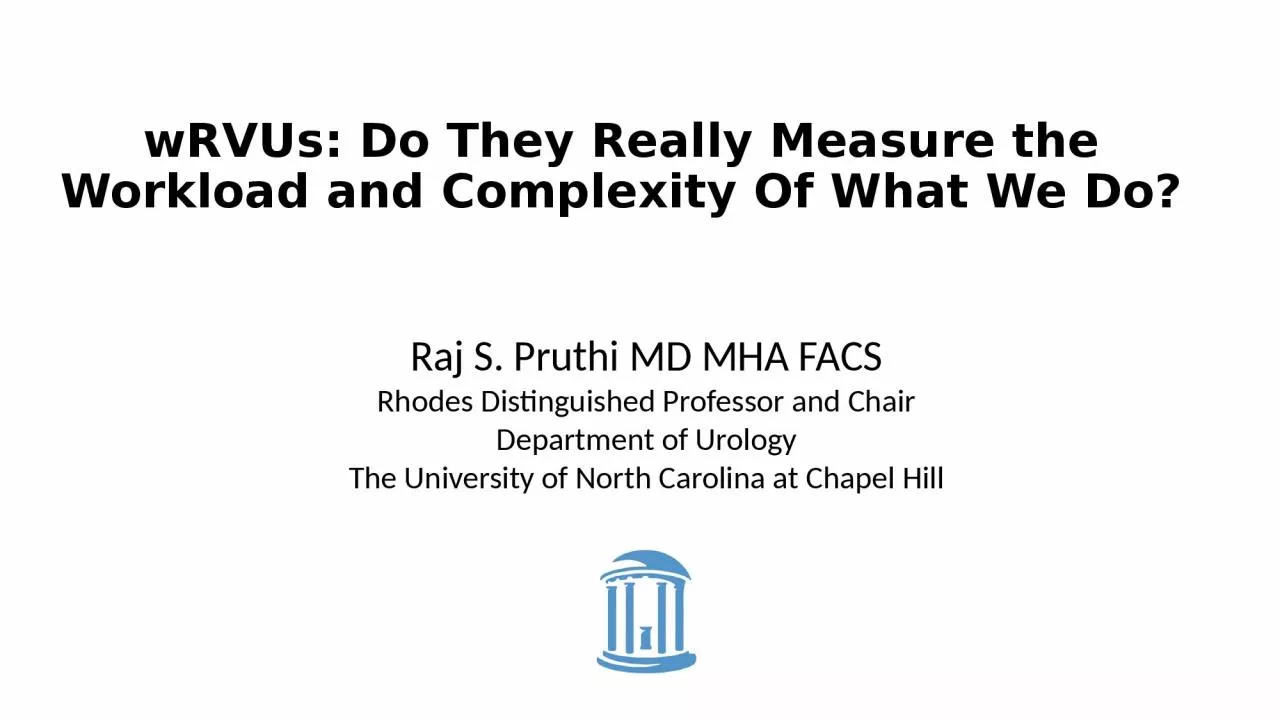

Raj S Pruthi MD MHA FACS Rhodes Distinguished Professor and Chair Department of Urology The University of North Carolina at Chapel Hill Productivitybased Compensation Increasing use of ID: 931325
Download Presentation The PPT/PDF document "wRVUs : Do They Really Measure the Workl..." is the property of its rightful owner. Permission is granted to download and print the materials on this web site for personal, non-commercial use only, and to display it on your personal computer provided you do not modify the materials and that you retain all copyright notices contained in the materials. By downloading content from our website, you accept the terms of this agreement.
Slide1
wRVUs: Do They Really Measure the Workload and Complexity Of What We Do?
Raj S. Pruthi MD MHA FACSRhodes Distinguished Professor and ChairDepartment of UrologyThe University of North Carolina at Chapel Hill
Slide2Productivity-based CompensationIncreasing use of
wRVU in employed compensation models2007 (16%) 2016 (> 60%)Use of benchmarked data (MGMA, AMGA, SC) to determine compensation/productivity ($/wRVU)e.g. AMGA $441,836 / 7649 = $57.76/
wRVU2
INTRODUCTION
Slide3wRVURBRVS - Developed for HCFA by
Hsaio et al (1986-92)Passed in 1989 -- implemented in 1992
INTRODUCTION
Slide4Payment
Rate
=
Work RVU
x Work GPCI
+
Practice Expense RVU
x PE GPCI
+
Malpractice RVU
x MP GPCI
x
Conversion
Factor
INTRODUCTION
GPCI = geographic practice cost index
Slide5INTRODUCTION
RVUs
metric of physician productivityRVUs : CPT code
Slide6urological services
405
22
383
Slide7Work = Time x Intensity
Slide8INTRODUCTION
Slide9100 units
Work
Slide10INTRODUCTION
RVU assignments initially made in consultation with nominees from various medical specialties
Quarterly adjustments based on survey dataZero sum game
Slide11Changes to Work RVUs
RUC
Summary of Recommendation
INTRODUCTION
Slide12Who Gets Surveys?Respondents selected by AUA by random sampling
May be sub-specialty, e.g. prostheticsMay be general, e.g. cysto with dilationPrivate practice (small & large), hospital-based, and academicNeed at least 30-50 responses -- ideally >100 responses
INTRODUCTION
Slide13Subjective methodology linked with compensation
Accurate measure of surgical complexity? workload? effort? time? difficulty?Controversy in literatureCorrelates with:complications in hepatic, vascular, plastic surgery
op time in pediatric surgeryPoor correlation with:op time, LOS, mortality in general surgery
INTRODUCTION
? Urology
Slide14METHODS
American College of Surgeons
National Surgical Quality Improvement Program
2012-2016
56
CPT codes
Work RVUs
Op time
LOS
Morbidity
Mortality
Serious Adverse
Events
Readmissions
Slide15METHODS
Exclusion criteria
Non-elective proceduresConcurrent CPT codes200,000 190,000 urologic procedures
included
small TURBT
cystectomy w/ urinary diversion
increasing RVUs
4.6
44
Slide16RESULTS
NSQIP Variable
R-SquaredLength of Stay
(LOS)
0.80
Operating Room Time
0.87
Morbidity
0.75
Mortality
0.52
Serious Adverse Events
0.65
Unplanned Readmissions
0.58
Slide17LOS
Outlying Procedures:
Lap Partial Nephrectomy
RVUs: 27.4
Median LOS: 2
Slide18Outlying Procedures:
Epididymovasostomy
RVUs: 14.2
OR Time: 182
mins
RPLND
RVUs: 17.7
OR Time: 256
mins
Op Time
Slide19Outlying Procedures:
Lap Partial Nephrectomy
RVUs: 27.4
Median Morbidity %: 4.4
Lap
Ureteroneocystotomy
RVUs: 25.7
Median Morbidity %: 4.7
Morbidity
Slide20Outlying Procedures:
None
Mortality
Slide21SAEs
Outlying Procedures:
Pyeloplasty
(complicated)
RVUS: 25.8
SAEs (%): 4.1
Lap Partial Nephrectomy
RVUs: 27.4
SAEs (%): 6.8
Slide22Readmission
Outlying Procedures:
Ureteroneocystotomy
(with ureteral tailoring)
RVUs: 20.7
Unplanned Readmissions (%): 16.7
Slide23RESULTS
NSQIP Variable
R-SquaredLength of Stay
(LOS)
0.80
Operating Room Time
0.87
Morbidity
0.75
Mortality
0.52
Adverse Events
0.65
Unplanned Readmissions
0.58
Slide24RESULTS
Slide25Work RVUs in urology correlate well with:
Op time (R² = 0.87)
LOS (R² = 0.80)
Morbidity (R² = 0.74)
Only moderately correlate with:
Mortality (R² = 0.51)
Serious Adverse Events (R² = 0.65)
Readmissions (R² = 0.57)
Outliers
Data-driven approach to improve RVU assignments
DISCUSSION
wRVU
=
3.14 + 6.64*(operative time in
hrs
) + 0.59*(LOS in days) +
0.37
*(readmission rate) + 0.06*(SAE rate) – 0.13*(death rate).
Slide26Importance of
wRVU to fairly and accurately measure workNeed to move from subjective assessment to objective measureEffort over 30-day post-operative periodReflect patient co-morbiditiesDoes not include quality / cost of care
Need to be consistent within specialty and across specialties
DISCUSSION
Slide27Op Time
Length of Stay
Surgical Specialty
Correlation Coefficient (R)
Estimated
mRVU
for 1hr procedure
Increase in mRVU per hour of op time
Correlation Coefficient (R)
Estimated mRVU for 1 day admission
Increase in mRVU per hospital day
Cardiac Surgery
0.51
27.21
9.20
0.47
27.20
4.43
General Surgery
0.86
14.84
11.28
0.60
16.58
2.93
Gynecology
0.84
13.47
11.45
0.72
18.67
7.38
Neurosurgery
0.80
17.65
12.90
0.42
29.95
2.25
Orthopedics
0.80
12.04
12.55
0.33
16.21
1.98
Otolaryngology (ENT)
0.97
9.04
9.51
0.81
17.24
5.83
Thoracic
0.91
16.15
8.12
0.54
17.48
2.20
Urology
0.92
11.85
8.70
0.81
15.38
5.50
Vascular
0.85
13.07
11.24
0.41
18.91
1.88
Overall
0.85
13.57
11.16
0.58
17.50
3.05
Slide28Op time
Slide29Correlation and Linear Regression between Risk Variables
mRVU
Readmission Rate
SAE Rate
Morbidity Rate
Mortality Rate
Surgical Specialty
Correlation Coefficient (R)
Change in
mRVU
for 10% increase
Correlation Coefficient (R)
Change in
mRVU
for 10% increase
Correlation Coefficient (R)
Change in
mRVU
for 10% increase
Correlation Coefficient (R)
Change in
mRVU
for 10% increase
Cardiac Surgery
0.01
0.65
0.60
6.82
0.59
6.99
0.71
50.58
General Surgery
0.46
14.32
0.65
9.20
0.63
7.36
0.22
11.69
Gynecology
0.70
29.15
0.61
8.27
0.65
8.33
0.36
98.72
Neurosurgery
0.43
17.34
0.45
6.32
0.39
4.11
0.08
2.32
Orthopedics
0.20
6.61
0.32
3.62
0.31
3.10
0.04
3.33
Otolaryngology
0.72
40.87
0.84
23.35
0.84
13.85
0.13
36.97
Thoracic
0.33
11.41
0.67
6.33
0.69
5.96
-0.03
-1.28
Urology
0.74
17.96
0.83
9.01
0.82
8.02
0.34
40.39
Vascular
0.01
0.17
0.71
5.32
0.71
5.21
0.47
10.45
Overall
0.42
13.00
0.61
6.70
0.62
6.10
0.29
12.50
Slide30Readmissions
Slide31SAEs
Slide32Morbidity
Slide33Conclusions
Importance of wRVU to fairly and accurately measure workNeed to move from subjective assessment to objective measureEffort over 30-day post-operative periodReflect patient co-morbiditiesDoes not include quality / cost of care
Need to be consistent within specialty and across specialtieswRVU = 3.14 + 6.64*(operative time in hrs
) + 0.59*(LOS in days) +
0.37
*(readmission rate) + 0.06*(SAE rate) – 0.13*(death rate).
Slide34QUESTIONS
Slide35